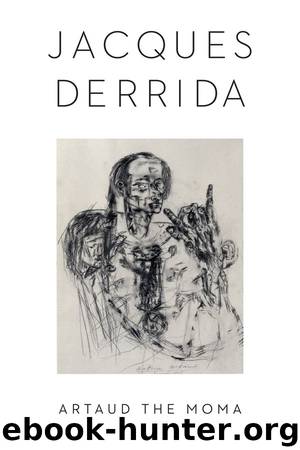Artaud the Moma by Jacques Derrida

Author:Jacques Derrida
Language: eng
Format: epub
Publisher: Columbia University Press
Published: 2017-09-19T04:00:00+00:00
I have moreover definitively broken with art, style, or talent in all the drawings one will see here. I mean to say woe to whoever might consider them as works of art, works of aesthetic simulation of reality.
Not one of them is properly speaking a work.
All are sketches, I mean blows of a sounding rod or a buttstock struck in all directions of chance, possibility, luck, or destiny.
I have not sought to refine my traits or my effects,
but to manifest in them kinds of patent linear truths [I underscore this manifestation of the truth according to lines or lineages], whose worth is as much in the words, the written phrases as in the graphism and the perspective of the traits.
It is thus that several drawings combine poems and portraits,
written interjections and plastic evocations of elements, materials, persons, men, or animals.
So one must accept these drawings in the barbarity and disorder of their graphism, “which has never been preoccupied with art,” but with the sincerity and spontaneity of the trait.14
Perhaps you still remember that I had promised to return to the “gris-gris,” to what Artaud himself calls, in the cited passage, “Gris-gris to return to man.” What is the time of these gris-gris in view of the return to man? What fate [sort] can we find for these Sorts (Spells)? What is their history and in what way do these bearers of blows also, and with the same blow, bear the question of the blow? The insistence of the doubled blow now leads us to complicate, in truth to disqualify, the concept of a history of art, thus of what founds this foundation that is a museum, namely, the concepts of art and of the work that are indissociable from the museum. One must also therefore dispute the rigor of a periodization in the graphic work of Artaud. In fact, another period or time, the third time if you like, would have come along first to blur the distinction between the two sequences I evoked a moment ago: first the time of disciplined training, during the 1920s and 1930s, which is to say the school exercise, the period of relative conventionality, of quasi realism in which is evidenced the maturity of a tested technique, and then the time of insurrection, the creative mutation, the seismic upheaval, which, after the electric lightning strike of 1939, after language has “left,” and especially from 1945 to 1948, the year of his death, would have given birth to a powerful, ingenious, and abundant graphic progeny; the latter, in fact, will increase by more than a factor of ten the earlier corpus by placing itself under the sign of the Mômo and of feigned or sarcastic awkwardness. This other time, the third one, but in chronological truth the second, would also come to wedge itself between the two others and ruin the very principle of a succession or a historic calendar of the works. This supplementary time would thus be neither a historical time nor properly speaking a third estate of Artaud’s revolution.
Download
This site does not store any files on its server. We only index and link to content provided by other sites. Please contact the content providers to delete copyright contents if any and email us, we'll remove relevant links or contents immediately.
| Anthropology | Archaeology |
| Philosophy | Politics & Government |
| Social Sciences | Sociology |
| Women's Studies |
Cecilia; Or, Memoirs of an Heiress — Volume 1 by Fanny Burney(32438)
Cecilia; Or, Memoirs of an Heiress — Volume 2 by Fanny Burney(31875)
Cecilia; Or, Memoirs of an Heiress — Volume 3 by Fanny Burney(31858)
The Great Music City by Andrea Baker(31516)
We're Going to Need More Wine by Gabrielle Union(18972)
All the Missing Girls by Megan Miranda(15590)
Pimp by Iceberg Slim(14398)
Bombshells: Glamour Girls of a Lifetime by Sullivan Steve(13978)
Talking to Strangers by Malcolm Gladwell(13231)
Norse Mythology by Gaiman Neil(13211)
Fifty Shades Freed by E L James(13162)
For the Love of Europe by Rick Steves(13081)
Mindhunter: Inside the FBI's Elite Serial Crime Unit by John E. Douglas & Mark Olshaker(9206)
Crazy Rich Asians by Kevin Kwan(9171)
The Lost Art of Listening by Michael P. Nichols(7411)
Enlightenment Now: The Case for Reason, Science, Humanism, and Progress by Steven Pinker(7240)
The Four Agreements by Don Miguel Ruiz(6637)
Bad Blood by John Carreyrou(6558)
Weapons of Math Destruction by Cathy O'Neil(6149)
